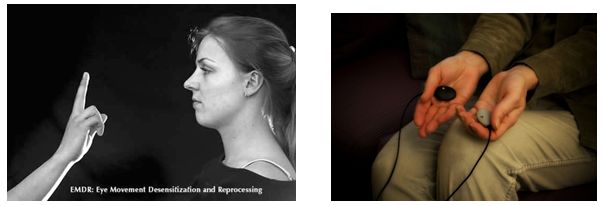Mental Health Matters: What is EMDR?
By: Jennifer Barr, LCSW
There are many different types of treatment for trauma and trauma-related diagnoses, like Post Traumatic Stress Disorder (PTSD). Some of you may be familiar with some of the available treatments. When considering a specific treatment or therapy, it is always important to speak with a professional, whether this is a medical doctor, psychiatrist, or licensed mental health professional! Today we’re going to talk about a type of trauma treatment called EMDR, which stands for Eye Movement Desensitization and Reprocessing. Some of you may be familiar with EMDR, or at least heard of it!
EMDR was developed by Francine Shapiro, PhD, and she spent over 20 years developing this treatment. EMDR is an evidenced-based practice, meaning there is a lot of research to back up EMDR as an effective treatment modality. EMDR is a validated treatment approach for Post Traumatic Stress Disorder, and is recommended by the Veteran’s Administration for trauma survivors. Evidenced-based practices are important, because mental health professionals want to use treatments that are widely accepted due to their effectiveness for a certain issue, like PTSD.
So, how does EMDR work? First, let’s think of the brain. EMDR focuses on the natural way our brain processes traumatic experiences. Most of us can think an experience that was particularly upsetting, perhaps the death of a loved one, a car accident, or being diagnosed with an illness. Many of us remember how upsetting that experience was, but can reflect back on our ability to process that experience in to something meaningful- something that “makes sense” to us. You may have noticed the negative feelings with that experience subsided, or even went away. This is because our brains are equipped in many ways to be resilient, and process upsetting events or memories naturally, and with other supports we have developed for ourselves (friends, family, healthy diet and exercise, to name a few). Sometimes, however, the event or memory is so upsetting, that it gets “stuck.” We may not be able to move the experience to that part of our brain that “makes sense” of what happens. We may feel physically sick, depressed, anxious, jittery, have nightmares, or other negative symptoms because of this memory. This is where EMDR comes in- it helps “stuck” memories become “unstuck” so that we can move forward with our lives in the best way possible.
EMDR uses an eight phase protocol that is implemented by a mental health professional trained, or certified, in EMDR. The clinician uses “BLS,” or bilateral stimulation, of the eyes. This means the clinician uses their fingers and moves them in a back and forth motion in front of the patient’s eyes, so that the pupils move from one corner of the eye to the other. The idea behind the BLS is that it simulates the processing that occurs in the brain during REM sleep. Have you ever watched someone’s pupils flicker underneath their eyelids when sleeping? Research has found that this bilateral stimulation used throughout the eight phases of the treatment model help the patient “process” the trauma. This doesn’t mean the memory of the trauma goes away! Most patients report feeling a sense of calm, release, or simply that the upsetting memory is no longer bothering them. The bilateral stimulation can also be done using a light bar, during which the patient’s eyes follow a light; with sound, during which the patient listens to sounds via head phones in alternating ears; and by touch, during which the patient holds a device that delivers alternating pulses to the hands. The visual BLS has been reported to be most effective, but it depends on patient preference.

EMDR can be hard to picture in your mind! Here is a great video that demonstrates the technique: http://www.youtube.com/watch?v=zBtqWrs2-K0
EMDR has proved to be a very effective treatment modality for trauma and PTSD. If you think this might be a possible treatment for you or someone you know, be sure to locate a provider who is EMDR trained, or certified. Here are some resources to use:
If you are interested learning about the specifc steps of the model, they are provided here, on the EMDR institute website: http://www.emdr.com/general-information/what-is-emdr/what-is-emdr.html
EMDR International Association for training, membership, research, find a therapist link and therapist support: www.EMDRIA.org
EMDR Humanitarian Assistance Program for training, materials, and service work: www.Emdrhap.org
EMDR additional training, information and resources: www.Emdr.com
Book: Getting Past Your Past
Written by EMDR Founder Francine Shapiro
